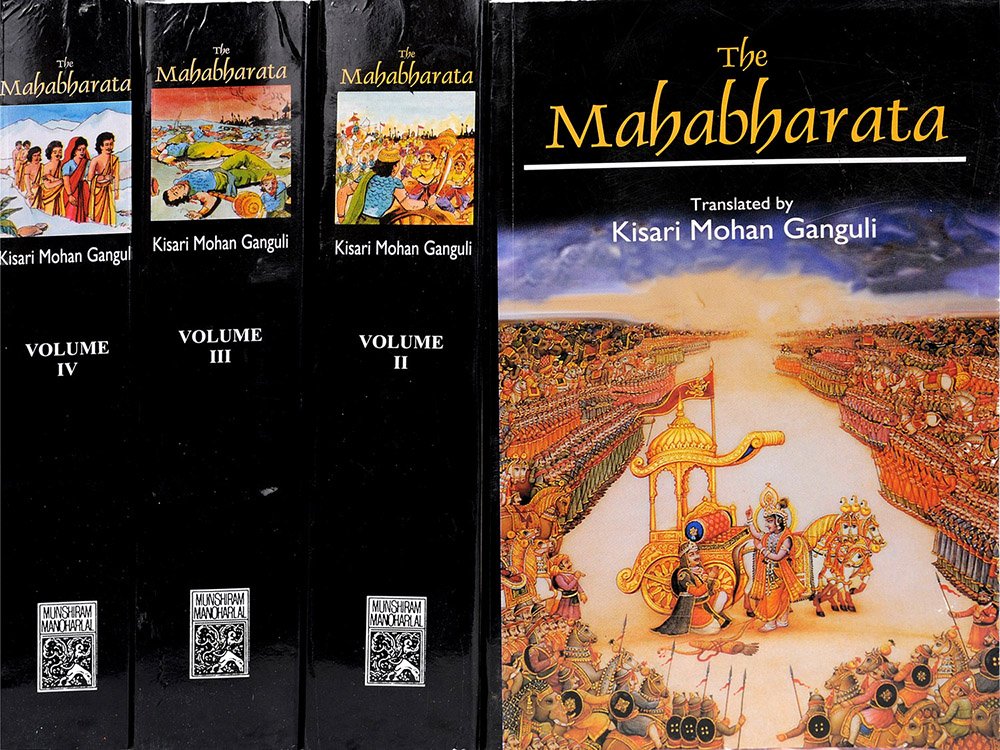Mahabharata (English)
by Kisari Mohan Ganguli | 2,566,952 words | ISBN-10: 8121505933
The English translation of the Mahabharata is a large text describing ancient India. It is authored by Krishna-Dwaipayana Vyasa and contains the records of ancient humans. Also, it documents the fate of the Kauravas and the Pandavas family. Another part of the large contents, deal with many philosophical dialogues such as the goals of life. Book...
Section LXIX
Sanjaya said,
"After the night had passed away and the sun had risen, the two armies, O king, approached each other for battle. Beholding each other, each rushed in united ranks towards the other excited with rage and desirous of vanquishing the other. And in consequence of your evil policy, O king, the Pandavas and the Dhartarashtras thus rushed, cased in mail and forming battle-array, for striking each other. And the array that Bhishma protected from all sides, O king, was of the shape of a Makara.[1] And so the Pandavas also, O king, protected the array they had formed (of their troops). Then your sire Devavrata, O great king, that foremost of car-warriors, proceeded in advance, supported by a large division of cars. And others, viz., car-warriors, infantry, elephants, and cavalry, all followed him, each stationed in the place allotted. And beholding them prepared for battle, the illustrious sons of Pandu arrayed their troops in that invincible and prince of arrays called the Syena.[2]
And in the beak of that array shone Bhimasena of great strength. And in its two eyes were the invincible Sikhandin and Dhrishtadyumna of Prishata’s race. And in the head was the heroic Satyaki of prowess incapable of being baffled. And in its neck was Arjuna shaking his Gandiva. And in its left wing was the high-souled and blessed Drupada with his son and supported by an akshauhini of all forces. And the king of the Kekayas, owning an akshauhini, formed the right wing (of that array). And in its back were the sons of Draupadi, and Subhadra’s son of great prowess. And in its tail was the heroic king Yudhishthira himself, of excellent prowess, supported by his twin brothers. Then in the battle (that ensued).
Bhima, penetrating the Makara array (of the Kauravas) through its mouth, and approaching Bhishma, covered him with his shafts. Then in that great battle, Bhishma possessed of great prowess shot his mighty weapons, confounding the combatants of the Pandavas disposed in battle-array. And when the combatants (of the Pandava army) were thus confounded, Dhananjaya, speedily proceeding, pierced Bhishma at the van of battle with a thousand arrows. And counteracting, in that conflict, the weapons shot by Bhishma, Arjuna stood ready for the combat, supported by his own division filled with cheerfulness.[3]
Then king Duryodhana, that foremost of mighty men, that great car-warrior, beholding that terrible carnage of his troops and remembering the slaughter of his brothers (on the previous day), came quickly towards Bharadvaja’s son, and addressing him, said,
'O preceptor, O sinless one, you are ever my well-wisher,—Relying on you as also on the grandsire Bhishma, ourselves, hope to vanquish without doubt the very gods in battle, let alone the sons of Pandu that are destitute of energy and prowess. Blessed be you, act in such away that the Pandavas may be slain.'
Thus addressed in battle by your son, Drona penetrated into the Pandava array in the very sight of Satyaki. Then O Bharata, Satyaki checked the son of Bharadvaja, (and thereupon) ensued a battle that was fierce in its incidents and awful to behold. Then Bharadvaja’s son excited with rage and endued with great prowess, as if smiling the while, pierced the grandson of Sini with ten shafts at his shoulder-joint. And Bhimasena also, excited with rage, pierced Bharadvaja’s son (with many shafts), desirous of protecting Satyaki, O king, from Drona that foremost of all warriors. Then Drona and Bhishma, and Salya also, O sire, excited with rage, covered Bhimasena, in that battle, with their shafts. Thereupon Abhimanyu excited with wrath, and the sons of Draupadi, O sire, pierced with their sharp-pointed shafts all those warriors with upraised weapons.
Then in that fierce battle, the great bowman Sikhandin rushed against those two mighty warriors, viz., Bhishma and Drona who, excited with rage, had (thus) fallen upon the Pandavas. Firmly grasping his bow whose twang resembled the roar of the clouds, that hero, shrouding the very Sun with his arrows, quickly covered his antagonists therewith. The grandsire of the Bharatas, however, getting Sikhandin before him, avoided him, remembering the femininity of his sex.
Then, O king, urged by your son, Drona rushed to battle, desirous of protecting Bhishma in that stress. Sikhandin, however, approaching Drona that foremost of all wielders of weapons, avoided, from fear, that warrior resembling the blazing fire that appears at the end of the Yuga. Then, O king, your son with a large force, desirous of winning great glory, proceeded to protect Bhishma. And the Pandavas also proceeded, O king, firmly setting their hearts upon victory, and the battle then that took place between the combatants of both armies desirous of victory and fame, was fierce and highly wonderful, resembling that (in days of yore) between the gods and Danavas.
Footnotes and references:
[1]:
A fabulous aquatic animal resembling an alligator.
[2]:
Formed after the shape of the hawk.
Conclusion:
This concludes Section LXIX of Book 6 (Bhishma Parva) of the Mahabharata, of which an English translation is presented on this page. This book is famous as one of the Itihasa, similair in content to the eighteen Puranas. Book 6 is one of the eighteen books comprising roughly 100,000 Sanskrit metrical verses.
